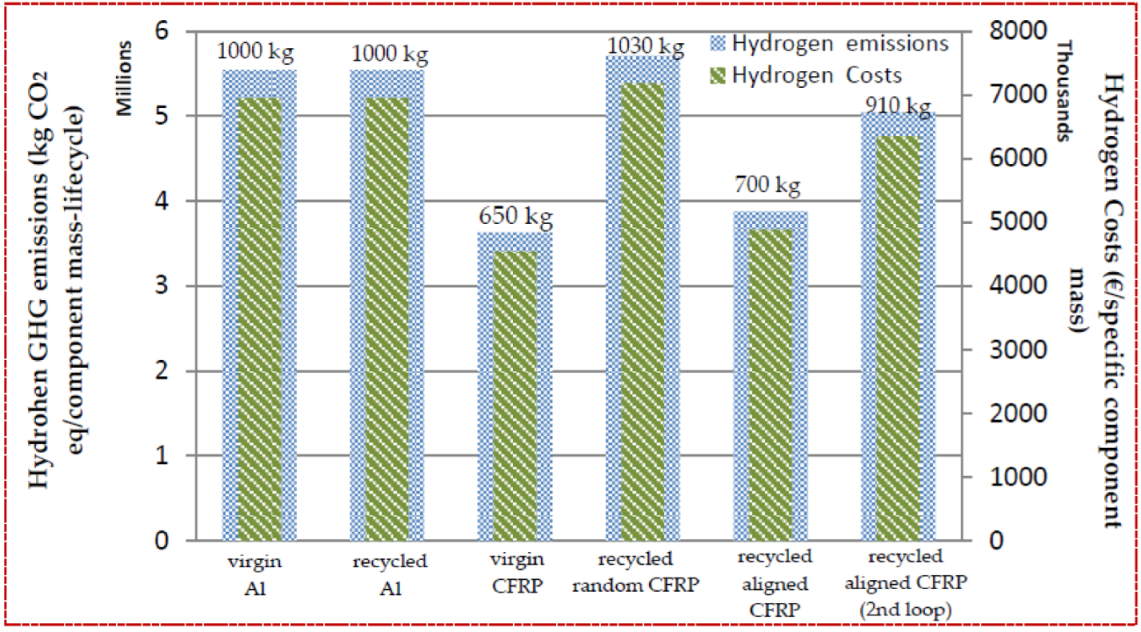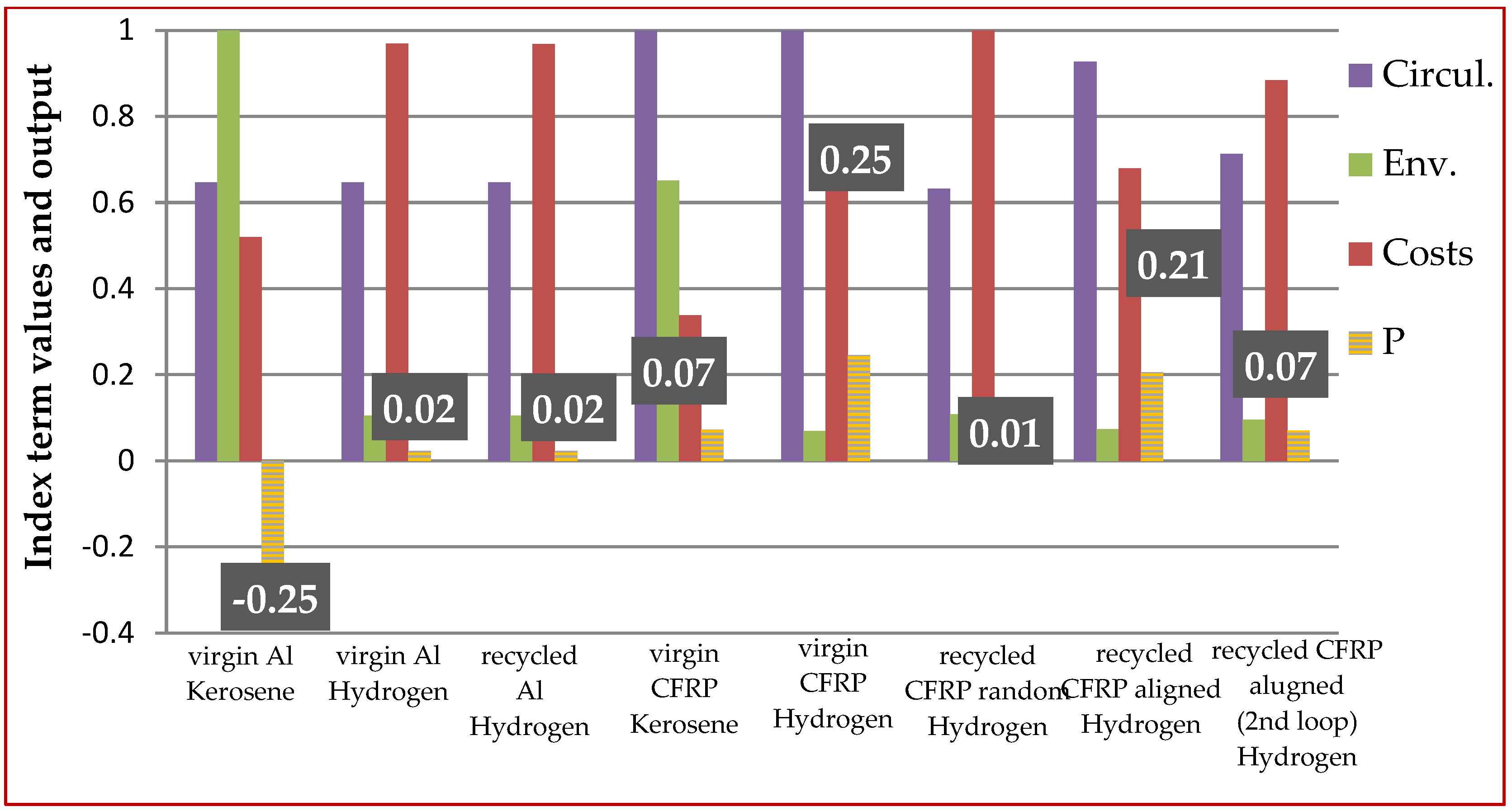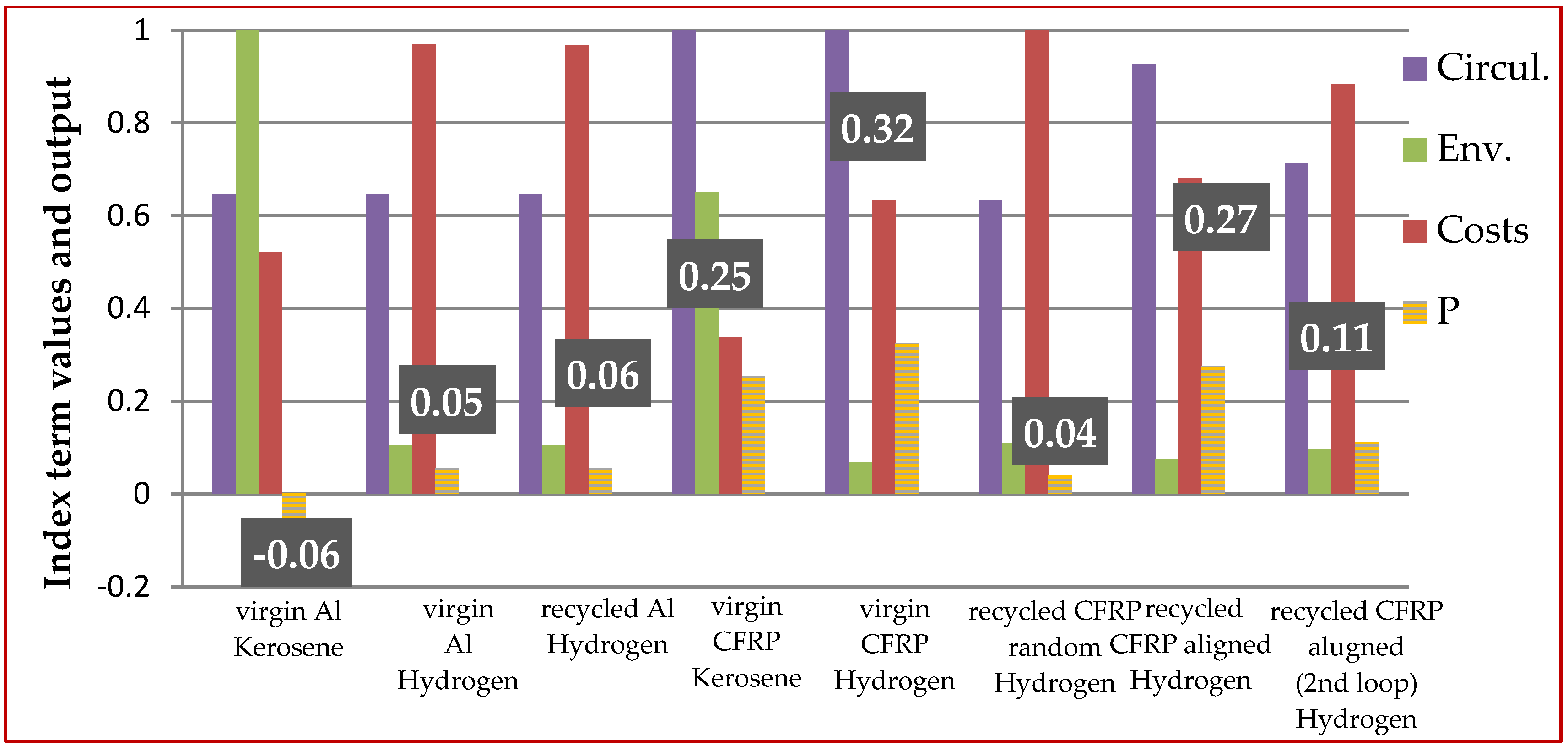Assessment of the Impact of Material Selection on Aviation Sustainability, from a Circular Economy Perspective
Abstract
:1. Introduction
2. Materials and Methods
2.1. Basic Considerations
2.2. Studied System and Methodological Framework
2.3. Definition of the Decision-Making Holistic Tool
3. Results and Discussion
3.1. Environmental and Economic Impact Comparison
3.2. Implementation of the Holistic Tool
3.2.1. Weight Factors Definition
3.2.2. Index Calculation
4. Conclusions
Author Contributions
Funding
Institutional Review Board Statement
Informed Consent Statement
Data Availability Statement
Conflicts of Interest
References and Note
- European Commission. Flightpath 2050, Europe’s Vision for Aviation; Report of the High Level Group on Aviation Research, Directorate-General for Research and Innovation, Directorate General for Mobility and Transport; European Commission: Brussels, Belgium, 2011; p. 28. [Google Scholar]
- Communication from the Commission to the European Parliament, the European Council, the Council, the European Economic and Social Committee and the Committee of the Regions the European Green Deal com/2019/640 final. Available online: https://www.eea.europa.eu/policy-documents/communication-from-the-commission-to-1 (accessed on 9 January 2022).
- Graver, B.; Rutherford, D.; Zheng, S. CO2 Emissions from Commercial Aviation: 2013, 2018, and 2019; Report of the ICCT (The International Council on Clean Transportation); ICCT: Binangonan, Philippines, 2020. [Google Scholar]
- Gnadt, A.R.; Speth, R.L.; Sabnis, J.S.; Barrett, S.R.H. Technical and environmental assessment of all-electric 180-passenger commercial aircraft. Prog. Aerosp. Sci. 2019, 105, 1–30. [Google Scholar] [CrossRef] [Green Version]
- Léonard, P.; Nylander, J. Sustainability assessment of composites in aero-engine components. In Proceedings of the Design Society: DESIGN Conference, Cavtat, Croatia, May 2020; pp. 1989–1998. [Google Scholar]
- Markatos, D.N.; Katsiropoulos, C.; Tserpes, K.; Pantelakis, S. A holistic End-of-Life (EοL) Index for the quantitative impact assessment of CFRP waste recycling techniques. Manuf. Rev. 2021, 8, 18. [Google Scholar]
- Zhang, J.; Chevali, V.S.; Wang, H.; Wang, C.H. Current status of carbon fibre and carbon fibre composites recycling. Compos. Part B Eng. 2020, 193, 108053. [Google Scholar] [CrossRef]
- Dincer, I.; Acar, C. A review on potential use of hydrogen in aviation applications. Int. J. Sustain. Aviat. 2016, 2, 74–100. [Google Scholar] [CrossRef]
- Acar, C.; Dincer, I. The potential role of hydrogen as a sustainable transportation fuel to combat global warming. Int. J. Hydrogen Energy 2020, 45, 3396–3406. [Google Scholar] [CrossRef]
- Bicer, Y.; Dincer, I. Life cycle evaluation of hydrogen and other potential fuels for aircrafts. Int. J. Hydrogen Energy 2017, 42, 10722–10738. [Google Scholar] [CrossRef]
- Saidani, M.; Yannou, B.; Leroy, Y.; Cluzel, F.; Kendall, A. A taxonomy of circular economy indicators. J. Clean. Prod. 2019, 207, 542–559. [Google Scholar] [CrossRef] [Green Version]
- Rigamonti, L.; Mancini, E. Life cycle assessment and circularity indicators. Int. J. Life Cycle Assess 2021, 26, 1937–1942. [Google Scholar] [CrossRef]
- Haupt, M.; Zschokke, M. How can LCA support the circular economy?—63rd discussion forum on life cycle assessment, Zurich, Switzerland, November 30, 2016. Int. J. Life Cycle Assess 2017, 22, 832–837. [Google Scholar] [CrossRef]
- Mantalovas, K.; Di Mino, G. Integrating circularity in the sustainability assessment of asphalt mixtures. Sustainability 2020, 12, 594. [Google Scholar] [CrossRef] [Green Version]
- Niero, M.; Kalbar, P.P. Coupling material circularity indicators and life cycle based indicators: A proposal to advance the assessment of circular economy strategies at the product level. Resour. Conserv. Recycl. 2019, 140, 305–312. [Google Scholar] [CrossRef]
- Tapper, R.J.; Longana, M.L.; Norton, A.; Potter, K.D.; Hamerton, I. An evaluation of life cycle assessment and its application to the closed-loop recycling of carbon fibre reinforced polymers. Compos. Part B Eng. 2020, 184, 107665. [Google Scholar] [CrossRef]
- Meng, F.; McKechnie, J.; Pickering, S.J. An assessment of financial viability of recycled carbon fibre in automotive applications. Compos. Part A Appl. Sci. 2018, 109, 207–220. [Google Scholar] [CrossRef] [Green Version]
- The Aluminum Association. The Environmental Footprint of Semi-Finished Aluminum Products in North America; A Life Cycle Assessment Report; The Aluminum Association: Arlington County, VA, USA, 2013. [Google Scholar]
- Deng, Y. Life Cycle Assessment of Biobased Fibre-Reinforced Polymer Composites. Ph.D. Thesis, KU Leuven, Science, Engineering & Technology, Leuven, Belgium, 2014. [Google Scholar]
- Shanley, F.R. Weight-Strength Analysis of Aircraft Structures, 2nd ed.; Dover Publications: Mineola, NY, USA, 1960. [Google Scholar]
- Patton, R.; Li, F. Causes of Weight Reduction Effects of Material Substitution on Constant Stiffness Components; SAE Technical: Warrendale, PA, USA, 2002. [Google Scholar]
- Li, F.; Patton, R.; Moghal, K. The relationship between weight reduction and force distribution for thin wall structures. Thin-Walled Struct. 2005, 43, 591–616. [Google Scholar] [CrossRef]
- Meng, F.; Olivetti, E.A.; Zhao, Y.; Chang, J.C.; Pickering, S.J.; McKechnie, J. Comparing life cycle energy and global warming potential of carbon fiber composite recycling technologies and waste management options. ACS Sustain. Chem. Eng. 2018, 6, 9854–9865. [Google Scholar] [CrossRef]
- EU Website. Electricity Price Statistics. Available online: https://ec.europa.eu (accessed on 22 October 2021).
- Suzuki, T.; Jun Takahashi, J. Prediction of energy intensity of carbon fiber reinforced plastics for mass-produced passenger cars. In Proceedings of the Ninth Japan International SAMPE Symposium, Tokyo, Japan, 29 November–2 December 2005. [Google Scholar]
- Ghosh, T.; Kim, H.C.; De Kleine, R.; Wallington, T.J.; Bakshi, B.R. Life cycle energy and greenhouse gas emissions implications of using carbon fiber reinforced polymers in automotive components: Front subframe case study. Sustain. Mater. Technol. 2021, 28, e00263. [Google Scholar] [CrossRef]
- Dér, A.; Dilger, N.; Kaluza, A.; Creighton, C.; Kara, S.; Varley, R.; Herrmann, C.; Thiede, S. Modelling and analysis of the energy intensity in polyacrylonitrile (PAN) precursor and carbon fibre manufacturing. J. Clean. Prod. 2021, 303, 127105. [Google Scholar] [CrossRef]
- AAA Air Support Website. Roll Forming and AAA Air Support. Available online: https://www.aaaairsupport.com (accessed on 22 October 2021).
- Bachman, J.; Hidalgo, C.; Bricout, S. Environmental analysis of innovative sustainable composites with potential use in aviation sector—A life cycle assessment review. Sci. Chin. Technol. Sci. 2017, 60, 1301–1317. [Google Scholar] [CrossRef] [Green Version]
- Hill, C.; Norton, A. Report—LCA Database of Environmental Impacts to Inform Material Selection Process; JCH Industrial Ecology Ltd. DACOMAT Project; European Union: Brussels, Belgium, 2019. [Google Scholar]
- Kim, H.C.; Wallington, T.J. Life cycle assessment of vehicle lightweighting: A physics-based model to estimate use-phase fuel consumption of electrified vehicles. Environ. Sci. Technol. 2016, 50, 11226–11233. [Google Scholar] [CrossRef] [PubMed]
- Duflou, J.; Deng, Y.; Van Acker, K.; Dewulf, W. Do fiber-reinforced polymer composites provide environmentally benign alternatives? A life-cycle-assessment-based study. MRS Bull. 2012, 37, 374–382. [Google Scholar] [CrossRef] [Green Version]
- Larsen, l.; Schuster, A.; Kim, J.; Kupke, M. Path planning of cooperating industrial robots using evolutionary algorithms. Procedia Manuf. 2018, 17, 286–293. [Google Scholar] [CrossRef]
- Airliners Website. Aircraft Technical Data and Specifications. Airbus A320. Available online: https://www.airliners.net (accessed on 22 October 2021).
- Das, S.K.; Kaufman, J.G. Recycling aluminum aerospace alloys. Adv. Mater. Process 2008, 166, 34–35. [Google Scholar]
- Zhao, D.; Guo, Z.; Xue, J. Research on scrap recycling of retired civil aircraft. IOP Conf. Ser. Earth Environ. Sci. 2021, 657, 012062. [Google Scholar] [CrossRef]
- Karuppannan Gopalraj, S.; Kärki, T. A study to investigate the mechanical properties of recycled carbon fibre/glass fibre-reinforced epoxy composites using a novel thermal recycling process. Processes 2020, 8, 954. [Google Scholar] [CrossRef]
- Meng, F.; Cui, Y.; Pickering, S.; McKechnie, J. From aviation to aviation: Environmental and financial viability of closed-loop recycling of carbon fibre composite. Compos. Part B Eng. 2020, 200, 108362. [Google Scholar] [CrossRef]
- Longana, M.L.; Ong, N.; Yu, H.; Potter, K.D. Multiple closed loop recycling of carbon fibre composites with the HiPerDiF (High Performance Discontinuous Fibre) method. Compos. Struct. 2016, 153, 271–277. [Google Scholar] [CrossRef] [Green Version]
- Katsiropoulos, C.V.; Pantelakis, S.G. A novel holistic index for the optimization of composite components and manufacturing processes with regard to quality, life cycle costs and environmental performance. Aerospace 2020, 7, 157. [Google Scholar] [CrossRef]
- Vo Dong, P.A.; Azzaro-Pantel, C.; Cadene, A. Economic and environmental assessment of recovery and disposal pathways for CFRP waste management. Resour. Conserv. Recycl. 2018, 133, 63–75. [Google Scholar] [CrossRef] [Green Version]
- Kalkanis, K.; Psomopoulos, C.S.; Kaminaris, S.; Ioannidis, G.; Pachos, P. Wind turbine blade composite materials—End of life treatment methods. Energy Procedia 2019, 157, 1136–1143. [Google Scholar] [CrossRef]
- Ighravwe, D.E.; Oke, S.A. A multi-criteria decision-making framework for selecting a suitable maintenance strategy for public buildings using sustainability criteria. J. Build. Eng. 2019, 24, 100753. [Google Scholar] [CrossRef]
- SuperDecisions Software: www.superdecisions.com. A program that is free to download and use for several months. For more information contact Creative Decisions Foundation, or email rozann@creativedecisions.net.
- Constellium. Airware® 2198-T8 Fuselage Sheet. Technical Datasheet; Constellium: Paris, France, 2017. [Google Scholar]
- European Commission’s Critical Raw Materials List. Available online: https://aluminiumtoday.com (accessed on 22 October 2021).
- Pinheiro Melo, S.; Barke, A.; Cerdas, F.; Thies, C.; Mennenga, M.; Spengler, T.S.; Herrmann, C. Sustainability assessment and engineering of emerging aircraft technologies—Challenges, methods and tools. Sustainability 2020, 12, 5663. [Google Scholar] [CrossRef]







| Investigated Components | ||||||
|---|---|---|---|---|---|---|
| Virgin Components | Recycled Components | |||||
| Aluminum | CFRP | Aluminum | CFRP (random fibers) | CFRP (aligned fibers) | CFRP (aligned fibers, 2nd loop) | |
| Component weight (kg) | 1000 | 650 | 1000 | 1030 | 700 | 910 |
| Circularity | Environmental Impact | Costs | Weight Factor/Priority | |
|---|---|---|---|---|
| Circularity | 1 | 1 | 1 | ≈33% |
| Environmental Impact | 1 | 1 | 1 | ≈33% |
| Costs | 1 | 1 | 1 | ≈33% |
| Circularity | Environmental Impact | Costs | Weight Factor/Priority | |
|---|---|---|---|---|
| Circularity | 1 | 1 | 2 | ≈40% |
| Environmental Impact | 1 | 1 | 2 | ≈40% |
| Costs | 0.5 | 0.5 | 1 | ≈20% |
| Circularity | Environmental Impact | Costs | Weight Factor/Priority | |
|---|---|---|---|---|
| Circularity | 1 | 2 | 2 | ≈50% |
| Environmental Impact | 0.5 | 1 | 1 | ≈25% |
| Costs | 0.5 | 1 | 1 | ≈25% |
Publisher’s Note: MDPI stays neutral with regard to jurisdictional claims in published maps and institutional affiliations. |
© 2022 by the authors. Licensee MDPI, Basel, Switzerland. This article is an open access article distributed under the terms and conditions of the Creative Commons Attribution (CC BY) license (https://creativecommons.org/licenses/by/4.0/).
Share and Cite
Markatos, D.N.; Pantelakis, S.G. Assessment of the Impact of Material Selection on Aviation Sustainability, from a Circular Economy Perspective. Aerospace 2022, 9, 52. https://doi.org/10.3390/aerospace9020052
Markatos DN, Pantelakis SG. Assessment of the Impact of Material Selection on Aviation Sustainability, from a Circular Economy Perspective. Aerospace. 2022; 9(2):52. https://doi.org/10.3390/aerospace9020052
Chicago/Turabian StyleMarkatos, Dionysios N., and Spiros G. Pantelakis. 2022. "Assessment of the Impact of Material Selection on Aviation Sustainability, from a Circular Economy Perspective" Aerospace 9, no. 2: 52. https://doi.org/10.3390/aerospace9020052
APA StyleMarkatos, D. N., & Pantelakis, S. G. (2022). Assessment of the Impact of Material Selection on Aviation Sustainability, from a Circular Economy Perspective. Aerospace, 9(2), 52. https://doi.org/10.3390/aerospace9020052






